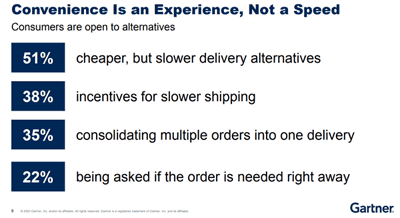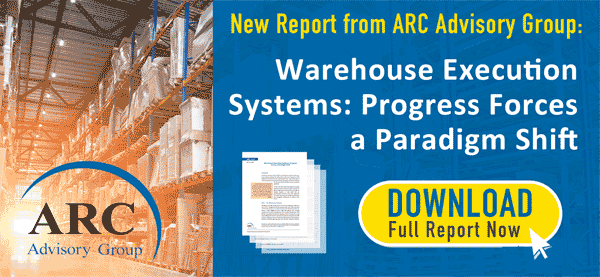Couch Report: Gartner Supply Chain Executive Symposium 2020 Part 2
A couple of weeks ago, I wrote an opening "couch report" on my experience with the Gartner Supply Chain Executive Symposium - which like all other conferences this year was delayed and then held as a virtual event the first week of November.
When attending in person, I called these conference reviews "trip reports." This year, viewing the presentations from the comfort of my office chair and living room sofa, you get a few"couch reports" instead.
Part 1 mostly focused on the important opening keynote presentation, which dealt with supply chain agility and resilience. (See Couch Report: Gartner Supply Chain Executive Symposium 2020.) This week, summaries of some additional presentations.
| GILMORE SAYS: |
Enright said a growing number of consumers seeing a single package delivered to their homes are asking if that shipping approach is causing environmental damage.
WHAT DO YOU SAY?
Send us your
Feedback here
|
The keynote presentation Thursday by Dr. Steve Robbins was on diversity and inclusion. I wasn't expecting much but it turned out to be quite interesting.
Robbins, who was born in Vietnam, started with a nice trick: he spoke with a heavy, almost exaggerated Asian accent, which the audience would assume was genuine. After a couple of minutes, he switched to his real voice, which has almost no accent at all.
I must confess my perception of Robbins and expectations for the session changed rather substantially based on which voice he used, so there is certainly some point there.
All human being, Robbins said, need two things: (1) to belong to a "tribe"; and (2) to be valued by that tribe. The human brain "is hard wired to belong," Robbins said.
Interestingly, while he early said he was speaking on diversity and inclusion, he said it was really the other way around - inclusion then diversity. Why? Robbins said that "If you don't build a culture of inclusion, diversity just makes it worse." If you create a real inclusive environment, when diverse people join the group, they will have a much better chance of thriving.
Robbins said that at any one time, the brain can actually only pay attention to one thing. He noted that in fac there is therefore really no such thing as multitasking. Not only that, attempts at multitasking are highly inefficient. That's because there is overhead in switching back and forth between tasks - time needed to get your thoughts back where they were after quitting one task for another and then back again. Stay focused on each task to completion, and you will get more done.
So tying back to inclusion, Robbins said if say in a meeting, a person's ideas are not really considered or solicited, this causes the person "social pain." And that pain is what research shows gets the brains attention - and again the brain can only focus on one thing at a time. Even if the person tries to toggle back and forth between the pain and work/task at hand, there will big drop in productivity given the overhead of switching attention.
In the end, the problem is not lack of diversity, Robbins said. The problem is close mindedness. Being open-minded doesn't mean accepting all new ideas, but it does mean being willing to entertain those ideas in a meaningful way - and being curious about people and ideas.
This all made sense to me, and I am glad I didn't skip the session as I was tempted to do.
I am very keen on the subject of supply chain agility, so looked forward to a session on that topic by Gartner analyst Jennifer Loveland.
She began with the basic observation that agility is need to real with uncertainly and rapid change - there is certainly a lot of that going around.
Loveland said there were multiple types of agility, starting with basic operational agility, of which there are two types: (1) fulfillment agility (being able to produce/distribute beyond the plan - and knowing how you would do it, at what cost); and (2) supply agility (being able to quickly adjust to changes in the supply environment, or in your company's demand signals).
Operating agility, Loveland said, was all about flexibility in short-term execution.
The next type she called design agility. This, she said, has to do with how fast the supply chain can respond to change in business models and strategies. The goal, she said, is to be able to create competitive advantage. I would add that in some cases it would mean playing catch-up if you are behind.
Again, there were two types of design agility. She cited as an example of "operating model agility" using so-called on-demand warehouse space providers such as Flexe and Stord to ramp up and down warehouse needs. I would just say this is an option for really any company, and the agility is a function of these kinds of companies creating the on-demand warehouse market, not so much the supply chain design of the companies using these services. Loveland then did reiterate how fast you can change your supply chain structure as an aspect of operating model agility.
Still under design agility is another sub-type, "outcome agility." What is that you ask? Loveland said it had to do with how fast you could give the customer something new. Pre-COVID, this generally meant how fast and effectively could the supply chain bring new products to market. With COVID, we saw many companies very quickly start making masks, ventilators and hand sanitizer, sometimes in just days.
I am not quite sure why all that comes under the name of "outcome agility."
Next, on the same level as operating and design agility, is offer agility. Loveland says that relates to what bundle of product and services a company can actually deliver to customers - and how fast as needs change. It is tied into increasing complexity, and tough decisions about where companies should embrace complexity, and where they should seek to simplify.
Once again, there are two types of offer agility: (1) experience alignment (meeting the customers need for price, speed and services - how precise can these attributes be combined for a custom, or the breadth of options); and (2) diversity (how many SKUs, site, supplier, etc. - the proposition being the more of these you have, the greater the offer agility.
With all that covered, Loveland said while many companies aim for greater agility, few can even define it internally. Loveland offers this: "Agility is how fast a response to changing requirements delivers significantly different outcomes effectively." Loveland then covred the five components that make up different aspects of agility, a framework that could be used to analyze where a company is at for the three different types of agility (operating, design and offer).
There was some goodness here, but it simply became too much and too complex I suspect for most.
Finally for this column, I attended a provocative session for sure on "responsible retailing" from Garter's Tom Enright. The basic proposition - a growing and important segment of the consumer market would rather have more sustainable packaging and shipping options than most retailers offer.
"What if you found out customers care more about the environment than you do, Enright asked early on.
Customers are in fact rethinking how they engage with retailers, and how they purchase products.
Historically, consumers made decisions based on three factors, Enright said: convenience, cost and speed. In the ecommerce era, he added, many have simply equated convenience with fast delivery.
But that isn't really accurate, Enright said - many consumers would be happy with ordering now and receiving the order many days later, even if the order process was convenient.
In fact, Enright says sustainability is fast becoming a key fourth factor in how consumers will make buying decisions - and for many will in fact be the most important factor.
He said a growing number of consumers seeing a single package delivered to their homes are asking if that shipping approach is causing environmental damage. Maybe they would rather have their orders consolidated with those of their neighbors, and have more sustainable delivery options offered by retailers. Consumers, he says, are asking how sustainable a retailer's shipping methods really are.
Enright cautions that certainly not all or even most consumers are thinking this way now, but that this sentiment is growing at such a pace that retailers cannot afford to ignore it.
As a result, Enright says retailers need to focus on three things: (1) Offering more sustainable shipping options, generally meaning slower deliveries; (2) Focus on using recyclable and even reusable packaging; and (3) Embracing "recommerce" - basically the sale of used merchandise, especially in apparel.

Boy I don't know. Enright sites some data points to back up his observations and recommendations, but it seems to me the market is overwhelmingly made up right now of Amazon Prime-addicted consumers who want it right now, with delivery getting about to the point it simply can't get there any faster. And we love it.
But I liked Enright's bold and passionate stance - even if the evidence of this trend for now is more in surveys than true buying behavior.
I'll be back next week with one more couch report from the Gartner conference.
Any reaction to Gilmore's thoughts on the election and the supply chain? Let us know your thoughts at the Feedback section below.
|












